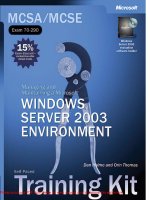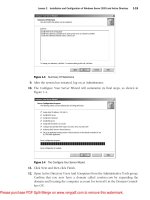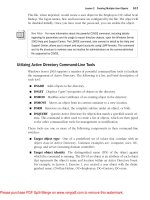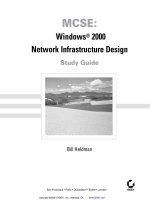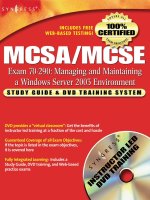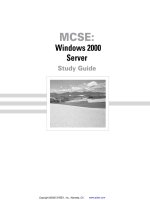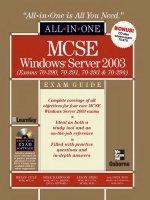Tài liệu MCSE Windows server 2003- P8 ppt
Bạn đang xem bản rút gọn của tài liệu. Xem và tải ngay bản đầy đủ của tài liệu tại đây (3.9 MB, 50 trang )
9 Maintaining the Operating
System
Exam Objectives in this Chapter:
■
Manage software update infrastructure
■
Manage software site licensing
Why This Chapter Matters
In 2002, the Code Red worm and its derivatives, Code Red v2 and Code Red II,
tore through the Internet, exploiting a hole in Microsoft Index Server. Although
the worms themselves did not cause tremendous damage, their astounding infec-
tion rate was a wake-up call to the tens of thousands of IT professionals who had
spent hours upon hours securing and updating their systems. The wake-up call
was particularly poignant because Microsoft had patched the Index Server vulner-
ability a month before the worms wreaked their havoc. It was clearer than ever
that servers and workstations must be kept current with code updates. Nor was it
a wise strategy to wait for Service Pack 3 before deploying Service Pack 2, as
many enterprises had done in the past. Software updates now became part and
parcel of the security strategies of an organization.
In this chapter, you will learn how to apply Microsoft Software Update Services
(SUS) to keep servers and desktops up to date. SUS allows an enterprise to cen-
tralize the downloading, testing, approval, and distribution of Windows-critical
updates and Windows security rollups. This service will play a significant role in
maintaining the integrity of your enterprise network. You will also learn how to
deploy Service Packs to one or more machines. Finally, you will examine the
components of site software licensing.
Lessons in this Chapter:
■
Lesson 1: Software Update Services . . . . . . . . . . . . . . . . . . . . . . . . . . . . . . . 9-3
■
Lesson 2: Service Packs . . . . . . . . . . . . . . . . . . . . . . . . . . . . . . . . . . . . . . . 9-22
■
Lesson 3: Administering Software Licenses . . . . . . . . . . . . . . . . . . . . . . . . . 9-25
9-1
Please purchase PDF Split-Merge on www.verypdf.com to remove this watermark.
9-2
Chapter 9 Maintaining the Operating System
Before You Begin
This chapter presents the skills and concepts related to administering Windows Soft-
ware Update Services, service pack deployment, and licensing. Although it is advanta-
geous to have two computers (a Microsoft Windows Server 2003 computer and a client
running Windows XP or Windows 2000 Professional), you can complete the exercises
in this chapter with only one computer. Prepare the following:
■
A Windows Server 2003 (Standard Edition or Enterprise Edition) installed as
Server01 and configured as a domain controller in the domain contoso.com
■
A first-level organizational unit (OU) named Desktops
■
Networking configured to provide Internet connectivity
Please purchase PDF Split-Merge on www.verypdf.com to remove this watermark.
Lesson 1 Software Update Services
9
-
3
Lesson 1: Software Update Services
To maintain a secure computing environment, it is critical to keep systems up to date
with security patches. Since 1998, Microsoft has provided Windows Update as a Web-
based source of information and downloads. With Windows XP and Windows 2000
service pack 3, Microsoft added Automatic Updates, whereby a system automatically
connects to Windows Update and downloads any new, applicable patches or “hot-
fixes.” Although the Windows Update servers and Automatic Updates client achieve
the goal of keeping systems current, many administrators are uncomfortable with
either computers or users deciding which patches should be installed, because a patch
might interfere with the normal functioning of a business-critical application.
The latest improvements to these technologies deliver Software Update Services (SUS).
SUS is a client-server application that enables a server on your intranet to act as a point
of administration for updates. You can approve updates for SUS clients, which then
download and install the approved updates automatically without requiring local
administrator account interaction.
In this lesson you will learn to install and administer SUS on a Windows Server 2003
computer. The following lesson will guide you through issues related to client
configuration.
After this lesson, you will be able to
■
Install SUS on a Windows Server 2003 computer
■
Configure SUS
■
Install or deploy Automatic Updates for SUS clients
■
Administer SUS and Automatic Updates
■
Monitor, troubleshoot, back up, and restore SUS
Estimated lesson time:
30 minutes
Understanding SUS
Since 1998, Microsoft Windows operating systems have supported Windows Update, a
globally distributed source of updates. Windows Update servers interact with client-
side software to identify critical updates, security rollups, and enhancements that are
appropriate to the client platform, and then to download approved patches.
Please purchase PDF Split-Merge on www.verypdf.com to remove this watermark.
9-4
Chapter 9 Maintaining the Operating System
Administrators wanted a more centralized solution that would assure more direct con-
trol over updates that are installed on their clients. Software Update Services is a
response to that need. SUS includes several major components:
■
Software Update Services, running on an Internet Information Services
(IIS) server The server-side component is responsible for synchronizing infor-
mation about available updates and, typically, downloading updates from the
Microsoft Internet-based Windows Update servers or from other intranet servers
running SUS.
■
The SUS administration Web site All SUS administration is Web-based. After
installing and configuring SUS, administration typically consists of ensuring that
the SUS server is synchronizing successfully, and approving updates for distribu-
tion to network clients.
■
Automatic Updates The Automatic Updates client is responsible for download-
ing updates from either Windows Update or an SUS server, and installing those
updates based on a schedule or an administrator’s initiation.
■
Group Policy settings Automatic Updates clients can be configured to synchro-
nize from an SUS server rather than the Windows Update servers by modifying the
clients’ registries or, more efficiently, by configuring Windows Update policies in
a Group Policy Object (GPO).
Installing SUS on a Windows Server 2003 Computer
SUS has both client and server components. The server component runs on a Windows
2000 Server (Service Pack 2 or later) or a Windows Server 2003 computer. Internet
Information Services (IIS) must be installed before setting up SUS and, as you learned
in Chapter 6, “Files and Folders,” IIS is not installed by default on Windows Server
2003. For information about how to install IIS, see Chapter 6.
SUS is not included with the Windows Server 2003 media, but it is a free download
from the Microsoft SUS Web site at
Note
The SUS download is not available in every localized language. However, this down-
load determines the installation and administrative interface for the server component only.
Patches for all locales can be made available through SUS.
Please purchase PDF Split-Merge on www.verypdf.com to remove this watermark.
Lesson 1 Software Update Services
9
-
5
After downloading the latest version of SUS, double-click the file and the installation
routine will start. After you agree to the license agreement, choose Custom setup and
the Setup Wizard will prompt you for the following information:
■
Choose File Locations Each Windows Update patch consists of two compo-
nents: the patch file itself and metadata that specifies the platforms and languages
to which the patch applies. SUS always downloads metadata, which you will use
to approve updates and which clients on your intranet will retrieve from SUS. You
can choose whether to download the files themselves and, if so, where to save the
updates.
Tip
If you elect to maintain the update files on Microsoft Windows Update servers, Auto
matic Updates clients will connect to your SUS server to obtain the list of approved updates
and will then connect to Microsoft Windows Update servers to download the files. You can
thereby maintain control of client updating and take advantage of the globally dispersed host
ing provided by Microsoft.
If you choose the Save The Updates To This Local Folder option, the Setup Wizard
defaults to the drive with the most free space, and will create a folder called SUS
on that drive. You can save the files to any NT file system (NTFS) partition;
Microsoft recommends a minimum of 6 gigabytes (GB) of free space.
Note
The SUS partition and the system partition must be formatted as NTFS.
■
Language Settings Although the SUS administrative interface is provided in
English and a few additional languages, patches are released for all supported
locales. This option specifies the localized versions of Windows servers or clients
that you support in your environment.
■
Handling New Versions Of Previously Approved Updates Occasionally, an
update itself is updated. You can direct SUS to approve automatically updates that
are new versions of patches that you have already approved, or you can continue
to approve each update manually.
■
Ready To Install Before installation begins, the Setup Wizard will remind you of
the URL clients should point to, http://SUS_servername. Note this path because
you will use it to configure network clients.
■
Installing Microsoft Software Update Services The Setup Wizard installs SUS.
■
Completing the Microsoft Software Update Services Setup Wizard The
final page of the Setup Wizard indicates the URL for the SUS administration site,
http://SUS_servername/SUSAdmin. Note this path as well, because you will admin-
ister SUS from that Web location. When you click Finish, your Web browser will
start and you will be taken automatically to the SUS administration page.
Please purchase PDF Split-Merge on www.verypdf.com to remove this watermark.
9-6
Chapter 9 Maintaining the Operating System
Software Update Services installs the following three components on the server:
■
The Software Update Synchronization Service, which downloads content to the
SUS server
■
An IIS Web site that services update requests from Automatic Updates clients
■
An SUS administration Web page, from which you can synchronize the SUS server
and approve updates
IIS Lockdown
When run on a Windows 2000 server, the SUS Setup Wizard launches the IIS
Lockdown Wizard to secure IIS 5.0. Windows Server 2003 is locked down by
default, so IIS Lockdown is not necessary.
If you have Web applications running on an IIS server, those applications may not
function properly after SUS has been installed. You can re-enable Internet Server
Application Programming Interface (ISAPI) filters and open other components
that are secured by IIS Lockdown. However, due to the sensitive nature of oper-
ating system updates, you should consider running SUS on a dedicated server
without other IIS applications.
Configuring and Administering SUS
You will perform three administrative tasks related to SUS: configuring SUS settings,
synchronizing content and approving content. These tasks are performed using the
SUS Administration Web site, shown in Figure 9-1, which can be accessed by navigat-
ing to http://SUS_servername/SUSAdmin with Internet Explorer 5.5 or later, or by open-
ing Microsoft Software Update Services from the Administrative Tools programs group.
The administration of SUS is entirely Web-based.
Note
You may need to add Server01 to the Local Intranet trusted site list to access the
site. Open Internet Explorer and choose Internet Options from the Tools menu. Click the Secu
rity tab. Select Trusted Sites and click Sites. Add Server01 and Server01.contoso.com to the
trusted site list.
Note
You must be a local administrator on the SUS server to administer and configure Soft-
ware Update Services. This is another consideration as you review dedicating the SUS server.
With a dedicated SUS ser ver, you can delegate administration of SUS without inadvertently
delegating authority over other server roles or applications.
Please purchase PDF Split-Merge on www.verypdf.com to remove this watermark.
Lesson 1 Software Update Services
9
-
7
Figure 9-1 The SUS Administration Web site
Configuring Software Update Services
Although some of the configuration of SUS can be specified during a custom installa-
tion, all SUS settings are accessible from the SUS Administration Web page. From the
Software Update Services administration page, click Set Options in the left navigation
bar. The Set Options page is shown in Figure 9-2.
Figure 9-2 The SUS Set Options page
Please purchase PDF Split-Merge on www.verypdf.com to remove this watermark.
9-8
Chapter 9 Maintaining the Operating System
The configuration settings are as follows:
■
Proxy server configuration If the server running SUS connects to Windows
Update using a proxy server, you must configure proxy settings.
Tip
Although the SUS server can be configured to access Windows Update through a proxy
server that requires authentication, the Automatic Updates client cannot access Windows
Update if the proxy server requires authentication. If your proxy server requires authentica
tion, you can configure SUS to authenticate, and you must store all update content—files as
well as metadata—locally.
■
DNS name of the SUS server In the Server Name box, type the fully qualified
domain name (FQDN) of the SUS server, for example, sus1.contoso.com.
■
Content source The first SUS servDer you install will synchronize its content
from Microsoft Windows Update. Additional SUS servers can synchronize from
Windows Update, from a “parent” SUS server, or from a manually created content
distribution point. See the sidebar, “SUS Topology” for more information.
■
New versions of approved updates The Set Options page allows you to mod-
ify how SUS handles new versions of previously approved updates. This option is
discussed earlier in the lesson.
■
File storage You can modify the storage of metadata and update files. This
option is also discussed earlier in the lesson.
Tip
If you change the storage location from a Windows Update server to a local server
folder, you should immediately perform a synchronization to download the necessary pack-
ages to the selected location.
■
Languages This setting determines the locale specific updates that are synchro-
nized. Select only languages for locales that you support in your environment.
Tip
If you remove a locale, the packages that have been downloaded are not deleted; how-
ever, clients will no longer receive those packages. If you add a locale, perform a manual syn
chronization to download appropriate packages for the new locale.
Please purchase PDF Split-Merge on www.verypdf.com to remove this watermark.
Lesson 1 Software Update Services
9
-
9
SUS Topology
Software Update Services is all about enabling you to control the approval and
distribution of updates from Microsoft Windows Update. In a small organization,
SUS can be as simple as one server, synchronizing from Windows Update and
providing a list of approved updates to clients.
In a larger organization, SUS topologies can be developed to make SUS more
scalable and efficient. Although the 70-290 certification exam expects you only
to administer existing topologies, it is helpful to understand some of the design
possibilities:
■
Multiple server topology Each SUS server synchronizes content from
Windows Update, and manages its own list of approved updates. This would
be a variation of a single-server model, and each SUS server administrator
would have control over that server’s list of approved updates. Such a config-
uration would also allow an organization to maintain a variety of patch and
update configurations (one per SUS server). Clients can be directed to obtain
updates from an SUS server with the appropriate list of approved updates.
■
Strict parent/child topology A “parent” SUS server synchronizes content
from Windows Update and stores updates in a local folder. The SUS admin-
istrator then approves updates. Other SUS servers in the enterprise synchro-
nize from the parent, and are configured, on the Set Options page, to
Synchronize List Of Approved Items Updated From This Location (Replace
Mode). This setting causes the child SUS servers to synchronize both the
update files and the list of approved updates. Network clients can then be
configured to retrieve updates from the SUS server in or closest to their site.
In this configuration (Synchronize List Of Approved Items), administrators of
child SUS servers cannot approve or disapprove updates; that task is man-
aged on the parent SUS server only.
■
Loose parent/child topology A “parent” SUS server synchronizes content
from Windows Update and stores updates in a local folder. Other SUS servers
in the enterprise synchronize from the parent. Unlike the strict configuration,
these additional SUS servers do not synchronize the list of approved updates,
so administrators of those servers can approve or disapprove updates inde-
pendently. Although this topology increases administrative overhead, it is
helpful when an organization wants to minimize Internet exposure (only the
parent SUS server needs to connect to the Internet), and requires (as in the
multiple-server model) distributed power of update approval or a variety of
client patch and update configurations.
Please purchase PDF Split-Merge on www.verypdf.com to remove this watermark.
9-10
Chapter 9 Maintaining the Operating System
■
Test/production topology This model allows an organization to create a
testing or staging of updates. The parent SUS server downloads updates from
Windows Update and an administrator approves updates to be tested. One
or more clients retrieve updates from the parent SUS server and act as test
platforms. Once updates have been approved, tested, and verified, the con-
tents of the parent SUS server are copied to a manually created content dis-
tribution point on a second IIS server. Production SUS servers synchronize
both the updates and the list of approved updates from the manual content
distribution point. The steps for configuring such a manual distribution point
are detailed in the Software Update Service Deployment White Paper, avail-
able from the Microsoft SUS Web site.
Synchronizing SUS
On the SUS Administration Web page, click Synchronize Server. On the Synchronize
Server page, as shown in Figure 9-3, you can start a manual synchronization or config-
ure automatic, scheduled synchronization. Click Synchronize Now and, when synchro-
nization is complete, you will be informed of its success or failure, and, if the
synchronization was successful, you will be taken to the Approve Updates page.
Figure 9-3 The Synchronize Server page
To schedule synchronization, click Synchronization Schedule. You can configure the
time of day for synchronization, as shown in Figure 9-4, and whether synchronization
occurs daily or weekly on a specified day. When a scheduled synchronization fails,
SUS will try again for the Number Of Synchronization Retries To Attempt setting.
Retries occur at 30-minute intervals.
Please purchase PDF Split-Merge on www.verypdf.com to remove this watermark.
Lesson 1 Software Update Services
9
-
11
Figure 9-4 The Schedule Synchronization Web Page Dialog page
Approving Updates
To approve updates for distribution to client computers, click Approve Updates in the
left navigation bar. The Approve Updates page, as shown in Figure 9-5, appears. Select
the updates that you wish to approve, then click Approve. If you are unsure about the
applicability of a particular update, click the Details link in the update summary. The
Details page that opens will include a link to the actual *.cab file that is used to install
the package, and a link to the Read More page about the update, which will open the
Microsoft Knowledge Base article related to the update.
Figure 9-5 The Approve Updates page
Please purchase PDF Split-Merge on www.verypdf.com to remove this watermark.
9-12
Chapter 9 Maintaining the Operating System
Tip
The first synchronization will download dozens of updates. It may be tedious to scroll
and click each check box for approval. Instead, after clicking the first check box, press TAB
twice to navigate to the next check box, and press the spacebar to select (or clear) the item.
The Automatic Updates Client
The client component of SUS is Windows Automatic Updates, which is supported on
Windows 2000, Windows XP, and Windows Server 2003. The Automatic Updates client
is included with Windows Server 2003, Windows 2000 Service Pack 3, and Windows XP
Service Pack 1.
For clients running earlier releases of the supported platforms, you can download
Automatic Updates as a stand-alone client from the Microsoft SUS Web site, at
The client, provided as an .msi file, can
be installed on a stand-alone computer or by means of Group Policy (assign the pack-
age in the Computer Configuration\Software Settings policy), SMS, or even a logon
script. If a localized version of the client is not available, install the English version on
any locale.
The Automatic Updates client of Windows Server 2003 is configured to connect auto-
matically to the Microsoft Windows Update server and download updates, then prompt
the user to install them. This behavior can be modified by accessing the Automatic
Updates tab in the System Properties dialog box, accessible by clicking System in Con-
trol Panel, in Windows XP and Windows Server2003. In Windows 2000 click Automatic
Updates in Control Panel. The Automatic Updates tab is shown in Figure 9-6. Auto-
matic Updates can also be configured using GPOs or registry values.
Figure 9-6 The Automatic Updates tab of the System Properties dialog box
Please purchase PDF Split-Merge on www.verypdf.com to remove this watermark.
Lesson 1 Software Update Services
9
-
13
Download Behavior
Automatic Updates supports two download behaviors:
■
Automatic Updates are downloaded without notification to the user.
■
Notification If Automatic Updates is configured to notify the user before down-
loading updates, it registers the notification of an available update in the system
event log and to a logged-on administrator of the computer. If an administrator is
not logged on, Automatic Updates waits for a user with administrator credentials
before offering notification by means of a balloon in the notification area of the
system tray.
Once update downloading has begun, Automatic Updates uses the Background Intel-
ligent Transfer Service (BITS) to perform the file transfer using idle network band-
width. BITS ensures that network performance is not hindered due to file transfer. All
patches are checked by the SUS server to determine if they have been correctly signed
by Microsoft. Similarly, the Automatic Updates client confirms the Microsoft signature
and also examines the cyclical redundancy check (CRC) on each package before
installing it.
Installation Behavior
Automatic Updates provides two options for installation:
■
Notification Automatic Updates registers an event in the system log indicating
that updates are ready for installation. Notification will wait until a local adminis-
trator is logged on before taking further action. When an administrative user is
logged on, a balloon notification appears in the system tray. The administrator
clicks the balloon or the notification icon, and then may select from available
updates before clicking Install. If an update requires restarting the computer, Auto-
matic Updates cannot detect additional updates that might be applicable until after
the restart.
■
Automatic (Scheduled) When updates have been downloaded successfully, an
event is logged to the system event log. If an administrator is logged on, a notifi-
cation icon appears, and the administrator can manually launch installation at any
time until the scheduled installation time.
At the scheduled installation time, an administrator who is logged on will be noti-
fied with a countdown message prior to installation, and will have the option to
cancel installation, in which case the installation is delayed until the next sched-
uled time. If a non-administrator is logged on, a warning dialog appears, but the
user cannot delay installation. If no user is logged on, installation occurs automat-
ically. If an update requires restart, a five-minute countdown notification appears
informing users of the impending restart. Only an administrative user can cancel
the restart.
Please purchase PDF Split-Merge on www.verypdf.com to remove this watermark.
9-14
Chapter 9 Maintaining the Operating System
Tip
If a computer is not turned on at the scheduled Automatic Updates installation time,
installation will wait to the next scheduled time. If the computer is never on at the scheduled
time, installation will not occur. Ensure that systems remain turned on to be certain that Auto
matic Updates install successfully.
Configuring Automatic Updates Through Group Policy
The Automatic Updates client will, by default, connect to the Microsoft Windows
Update server. Once you have installed SUS in your organization, you can direct Auto-
matic Updates to connect to specific intranet servers by configuring the registry of cli-
ents manually or by using Windows Update group policies.
To configure Automatic Updates using GPOs, open a GPO and navigate to the Com-
puter Configuration\Administrative Templates\Windows Components\Windows
Update node. The Windows Update policies are shown in Figure 9-7.
Figure 9-7 Windows Update policies
Note
If you edit policy on a Windows 2000 Active Directory server, the policies may not
appear. Automatic Updates policies are described by the %Windir%\Inf\Wuau.inf administra
tive template, which is installed by default when Automatic Updates is installed. If Automatic
Updates has not been installed on the domain controller to which you are connected (typi
cally, the PDC Emulator), you must right-click the Administrative Templates node and choose
Add/Remove Templates, click Add, then locate the Wuau.inf template, perhaps by copying it
from a system that does have Automatic Updates installed.
Please purchase PDF Split-Merge on www.verypdf.com to remove this watermark.
Lesson 1 Software Update Services
9
-
15
The following policies are available, each playing an important role in configuring
effective update distribution in your enterprise:
■
Configure Automatic Updates The Configure Automatic Updates Behavior
determines the behavior of the Automatic Updates client. There are three options:
Notify For Download And Notify For Install, Auto Download And Notify For
Install, and Auto Download And Schedule The Install. These options are combina-
tions of the installation and download behaviors discussed earlier in the lesson.
■
Reschedule Automatic Updates Scheduled Installations If installations are
scheduled, and the client computer is turned off at the scheduled time, the default
behavior is to wait for the next scheduled time. The Reschedule Automatic
Updates Scheduled Installations policy, if set to a value between 1 and 60, causes
Automatic Updates to reschedule installation for the specified number of minutes
after system startup.
■
No Auto-Restart For Scheduled Automatic Updates Installations This policy
causes Automatic Updates to forego a restart required by an installed update when
a user is logged on to the system. Instead, the user is notified that a restart is
required for installation to complete, and can restart the computer at his or her dis-
cretion. Remember that Automatic Updates cannot detect new updates until restart
has occurred.
■
Specify Intranet Microsoft Update Service Location This policy allows you
to redirect Automatic Updates to a server running SUS. By default, the client will
log its interactions on the SUS server to which it connects. However, this policy
allows you to point clients to another server running IIS for statistics logging. This
dual policy provides the opportunity for clients to obtain updates from a local SUS
server, but for all clients to log SUS statistics in a single location for easier retrieval
and analysis of the log data, which is stored as part of the IIS log. IIS logs typically
reside in %Windir%\System32\Logfiles\W3svc1.
Automatic Updates clients poll their SUS server every 22 hours, minus a random offset.
Any delay in patching should be treated as unacceptable when security vulnerabilities
are being actively exploited. In such situations, install the patch manually so that sys-
tems do not have to wait to poll, download, and install patches.
After approved updates have been downloaded from the SUS server, they will be
installed as configured—manually or automatically—at the scheduled time. If an
approved update is later unapproved, that update is not uninstalled; but it will not be
installed by additional clients. An installed update can be uninstalled manually, using
the Add Or Remove Programs application in Control Panel.
Please purchase PDF Split-Merge on www.verypdf.com to remove this watermark.
9-16
Chapter 9 Maintaining the Operating System
SUS Troubleshooting
Although SUS works well, there are occasions that warrant monitoring and trouble-
shooting.
Monitoring SUS
The Monitor Server page of the SUS Administration Web site displays statistics that
reflect the number of updates available for each platform, and the date and time of the
most recent update. The information is summarized from the Windows Update meta-
data that is downloaded during each synchronization. Metadata information is written
to disk and stored in memory to improve performance as systems request platform
appropriate updates.
You can also monitor SUS and Automatic Updates using the following logs:
■
Synchronization Log You can retrieve information about current or past syn-
chronizations, and the specific packages that were downloaded by clicking View
Synchronization Log in the left navigation bar. You can also use any text editor to
open the (Extensible Markup Language) XML–based database (History-Sync.xml)
directly from the SUS Web site’s \AutoUpdate\Administration directory in IIS.
■
Approval Log For information about packages that have been approved, click
View Approval Log in the left navigation bar. Alternatively, you can open History-
Approve.xml from the SUS Web site’s \AutoUpdate\Administration directory in IIS.
■
Windows Update Log The Automatic Updates client logs activity in the
%Windir%\Windows Update.log file on the client’s local hard disk.
■
Wutrack.bin The client’s interaction with SUS is logged to the specified statistics
server’s IIS logs, typically stored in the folder: %Windir%\System32\Logfiles
\W3svc1. These logs, which are verbose and cryptic, are designed to be analyzed
by programs, not by humans.
!
Exam Tip
Although you should know what logs are available, and where they are located,
you are not required for the 70-290 exam to be able to interpret cryptic messages or log
entries. The SUS Deployment White Paper includes appendices with detailed information
about event descriptions and log syntax.
SUS System Events
The synchronization service generates event log messages for each synchronization per-
formed by the server, and when updates are approved. These messages can be viewed
in the System log using Event Viewer. The events relate to the following scenarios:
Please purchase PDF Split-Merge on www.verypdf.com to remove this watermark.
Lesson 1 Software Update Services
9
-
17
■
Unable to connect Automatic Updates could not connect to the update service
(Windows Update or the computer’s assigned SUS server).
■
Install ready—no recurring schedule Updates listed in the event were down-
loaded and are pending installation. An administrator must click the notification
icon and click Install.
■
Install ready—recurring schedule Updates listed in the event are down-
loaded and will be installed at the date and time specified in the event.
■
Installation success Updates listed in the event were installed successfully.
■
Installation failure Updates listed in the event failed to install properly.
■
Restart required—no recurring schedule An update requires a restart. If
installation behavior is set for notification, restart must be performed manually.
Windows cannot search for new updates until the restart has occurred.
■
Restart required—recurring schedule When Automatic Updates is config-
ured to automatically install updates, an event is registered if an update requires
restart. Restart will occur within five minutes. Windows cannot search for new
updates until after the restart has occurred.
Troubleshooting SUS
Software Update Services on a Windows Server 2003 computer may require the follow-
ing troubleshooting steps:
■
Reloading the memory cache If no new updates appear since the last time
you synchronized the server, it is possible that no new updates are available.
However, it is also possible that memory caches are not loading new updates
properly. From the SUS administration site, click Monitor Server and then click
Refresh.
■
Restarting the synchronization service If you receive a message that the syn-
chronization service is not running properly, or if you cannot modify settings in
the Set Options page of the administration Web site, open the Microsoft Manage-
ment Console (MMC) Services snap-in, right-click Software Update Services Syn-
chronization Service and choose Restart.
■
Restarting IIS If you cannot connect to the administration site, or if clients can-
not connect to the SUS serve, restart the World Wide Web Publishing Service in the
same manner.
If Automatic Updates clients do not appear to be receiving updates properly,
open the registry of a client and ensure that the following values appear in
HKEY_LOCAL_MACHINE\Software\Policies\Microsoft\Windows\WindowsUpdate:
Please purchase PDF Split-Merge on www.verypdf.com to remove this watermark.
9-18
Chapter 9 Maintaining the Operating System
■
WUServer Should have the URL of the SUS server, for example, http:
//SUS_Servername
■
WUStatusServer Should have the URL of the same SUS server or another IIS
server on which synchronization statistics are logged
And, in the AU subkey:
■
UseWUServer Should be set to dword:00000001
SUS Backup and Recovery
As with any other server role or application, you must plan for recovery in the event of
a server failure.
Backing Up SUS
To back up SUS, you must back up the folder that contains SUS content, the SUS
Administration Web site, and the IIS metabase.
!
Exam Tip
The process described to back up the IIS metabase is useful not only for backing
up SUS, but for any other Web site or application running on Windows Server 2003 and IIS 6.0.
First, back up the metabase—an XML database containing the configuration of IIS.
Using the MMC IIS snap-in, select the server to back up and, from the Action menu,
select All Tasks, then Backup/Restore Configuration. Click Create Backup and enter a
name for the backup. When you click OK, the metabase is backed up.
Then back up the following using Ntbackup or another backup utility:
■
The default Web site, which is located unless otherwise configured in C:\Inetpub
\Wwwroot.
■
The SUS Administration Web site. SUSAdmin is, by default, a subfolder of
C:\Inetpub\Wwwroot. In that event, it will be backed up when you back up the
default Web site.
■
The AutoUpdate virtual directory, also by default a subfolder of C:\Inetpub
\Wwwroot.
■
The SUS content location you specified in SUS setup or the SUS options. You can
confirm the SUS content location in IIS manager by clicking Default Web Site and
examining the path to the Content virtual root in the details pane.
■
The metabase backup directory, %Windir%\System32\Inetsrv\Metaback, which
contains the copy of the metabase made earlier.
Please purchase PDF Split-Merge on www.verypdf.com to remove this watermark.
Lesson 1 Software Update Services
9
-
19
See Also
For more information about the Ntbackup utility, see Chapter 7.
This process of backing up the metabase, and then backing up the components of SUS,
should be repeated regularly because updates will be added and approved with some
frequency.
SUS Server Recovery
To restore a failed SUS server, perform the steps described below. If a certain step is
unnecessary, you may skip it, but perform the remaining steps in sequence.
1. Disconnect the server from the network to prevent it from being infected with
viruses.
2. Install Windows Server 2003, being sure to give the server the same name it had
previously.
3. Install IIS with the same components it had previously.
4. Install the latest service pack and security fixes. If the server must be connected to
the network to achieve this step, take all possible precautions to prevent unnec-
essary exposure.
5. Install SUS into the same folder it was previously installed.
6. Run Ntbackup to restore the most recent backup of SUS. This will include the SUS
content folder, the Default Web Site, including the SUSAdmin and AutoUpdate vir-
tual directories, and the IIS metabase backup.
7. Open the MMC IIS snap-in and select the server to restore. From the Action menu,
select All Tasks, then Backup/Restore Configuration and select the backup that
was just restored. Click Restore.
8. Confirm the success of your recovery by opening the SUS Administration Web site
and clicking Set Options. Check that the previous settings are in place, and that
the previously approved updates are still approved.
Note
The preceding steps apply to Windows Server 2003 only. If you are recovering a
Windows 2000-based SUS server, refer to SUS documentation for appropriate steps.
Please purchase PDF Split-Merge on www.verypdf.com to remove this watermark.
9-20
Chapter 9 Maintaining the Operating System
Lesson Review
The following questions are intended to reinforce key information presented in this
lesson. If you are unable to answer a question, review the lesson materials and try the
question again. You can find answers to the questions in the “Questions and Answers”
section at the end of this chapter.
1. You are configuring a Software Update Services infrastructure. One server is syn-
chronizing metadata and content from Windows Update. Other servers (one in
each site) are synchronizing content from the parent SUS server. Which of the fol-
lowing steps is required to complete the SUS infrastructure?
a. Configure Automatic Updates clients using Control Panel on each system
b. Configure GPOs to direct clients to the SUS server in their sites
c. Configure a manual content distribution point
d. Approve updates using the SUS administration page
2. You are configuring SUS for a group of Web servers. You want the Web servers to
update themselves nightly based on a list of approved updates on your SUS server.
However, once in a while an administrator is logged on, performing late-night
maintenance on a Web server, and you do not want update installation and poten-
tial restart to interfere with those tasks. What Windows Update policy configura-
tion should you use in this scenario?
a. Notify For Download And Notify For Install
b. Auto Download And Notify For Install
c. Auto Download And Schedule The Install
3. You want all network clients to download and install updates automatically during
night hours, and you have configured scheduled installation behavior for Auto-
matic Updates. However, you discover that some users are turning off their
machines at night, and updates are not being applied. Which policy allows you to
correct this situation without changing the installation schedule?
a. Specify Intranet Microsoft Update Service Location
b. No Auto-Restart For Scheduled Automatic Updates Installations
c. Reschedule Automatic Updates Scheduled Installations
d. Configure Automatic Update
Please purchase PDF Split-Merge on www.verypdf.com to remove this watermark.
